










Several years ago, I answered one of those Q&As on Facebook. It was a “getting to know you” thing — not unlike filling out a purga torial online dating profile — but ultimately just FB collecting data.
Among the questions was, “What would you buy if you won the lot tery?” It had to be something you would purchase, for yourself. Two disparate things leapt to mind simultaneously: a pool table and a horse.
Soon after, I bought a gently used (and super cheap!) pool table from craigslist. It was fetched, disassembled, carried into my apartment, and reassembled by a rather sketchy band of gentlemen led by an even sketchier acquaintance, who drove off in the van I’d rented for an uncomfortable length of time to “grab a couple guys,” returning with five. So much for the 50 bucks, case of beer, and large pizza I’d planned to foist on him; he’d insisted that he’d do it alone for free, having been a recent guest at my Thanksgiving table (long story). I cried when it was finally assembled. I’d taught myself to play on my downstairs neighbor’s table after a brain injury in my twenties had left me unable to work for a year. My godfather/uncle was a pool shark, and, to a lesser degree, so was my dad. Genetic? Maybe. And yes, once recovered, I hustled in bars. Pool is the only math I’m good at.
The horse…well, that’s been a tougher get. I have loved them since childhood, voraciously tore through every horse book I could find. Other friends had Barbies; I had poseable horse figurines. We lived in West Philadelphia, and the only horses I saw carried police officers, except during our Sunday drives through Chester County. Occasionally my father would get a side job on a farm, and he always took me along. My parents couldn’t afford riding lessons, so I took dance instead. Years ago, I tried to persuade a publisher to let me take les sons and write about it for his magazine. Nope. I took them anyway. I also took some during that year of recovery, much to my mother’s chagrin.
The thought “I need to get on a horse soon” crosses my mind on a regular basis. Maybe someday I’ll acquire one for real.
In the meantime, I hope you enjoy Kelly Murray’s feature about the thriving WC horse scene in this issue as much as I did. It’s a fascinating peek into local life with these magnifi cent creatures. And what’s the old saw about being upstaged by kids and animals? We have kids here, too. They’re incred ibly talented young skaters whose hard work has paid off in a big—as in national big—way. Finally, Jesse Piersol delivers an excellent story about a timely and important organization, the Goose Creek Alliance. It should be required reading for anyone living in town, and it’s a great cause to consider sup porting.
Thank you for reading The WC Press, and welcome to fall in West Chester! kate@thewcpress.com

PUBLISHER Dan Mathers dan@thewcpress.com
ADVERTISING MANAGER Nick Vecchio nick@thewcpress.com
MANAGING EDITOR Kate Chadwick kchadwick@thewcpress.com
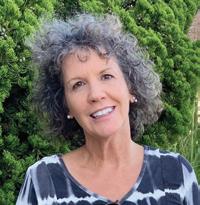
CONTRIBUTING EDITORS Jesse Piersol jpiersol@thewcpress.com
Danielle Davies ddavies@thewcpress.com Kelly Murray kmurray@thewcpress.com
STAFF PHOTOGRAPHER Erik Weber @westchesterviews
“I hope I can be the autumn leaf, who looked at the sky and lived. And when it was time to leave, gracefully it knew life was a gift.” –Dodinsky
COLUMNISTS
Becca Boyd bboyd@thewcpress.com
Andrea Mason amason@thewcpress.com DJ Romeo romeo@thewcpress.com Kate Chadwick kchadwick@thewcpress.com
Published By... Mathers Productions 1271 Phoenixville Pk West Chester, PA 19380 mathersproductions.com 610-299-1100
The WC Press is a monthly magazine mailed to more than 3,000 homes throughout West Chester, as well as being dropped off to about 100 locations in and around the borough. For a free subscription — digital or mailed — visit thewcpress.com.
Our favorite social media posts, in print
TELL ME SOMETHING GOOD
We spotlight citizens for doing something swell
The organization restoring the health of Goose Creek
Our resident interior designer helps you upgrade your space
A glimpse into the life of West Chester’s equestrian community
MARKET FORECAST
Your planetary predictions with a particularly local twist
FROM WEST CHESTER TO THE STATE GAMES
Ice Line skaters go for the gold
Becca Boyd shares tips on life and cooking
PHOTO HUNT
Spot the five differences and win a Barnaby’s gift card
DJ Romeo curates a list of songs you’ll be singing this spring
Chadwick shares some personal insight into this month’s theme











Danielle Davies spotlights citizens for doing something swell. This month, meet Pachy Banks-Cabral

What she does: Pachy has been the Director of Development of the Chester County History Center for six months. Pachy isn’t new to devel opment—she was previously at Main Line Art Center in Haverford and the Please Touch Museum in Philadel phia—but her move to Honeybrook propelled her towards Chester County History Center. “I wanted to work somewhere closer to home and this job is a great fit. I love the History Center and what we do.”
Why she’s on this page: Pachy isn’t just here to support West Chester, she’s interested in West Chester’s role in the history of the country. “The History Center is the holder of 300 years of county history. It has a vast collection of artifacts, books, docu ments, and photographs—close to a million items between all of them,” says Pachy. “I love to learn how West Chester was involved in the national landscape. I learned that this gentleman Raymond Rettew was responsible for figuring out how to mass produce penicillin. This is a man from West Chester. I was blown away! They say his discovery saved thousands of lives in World War II.”
What we admire about her: Her contagious enthusiasm. If you aren’t interested in history, Pachy can change your mind. “I find this extremely exciting and want to get these stories out there. We are important and have a national impact.”

What the Chester County History Center has been up to: Pachy is helping to expand on the success of the center’s annual Hal loween Ball. The staple event supports the Center’s education programs and Pachy is determined to make this year another success. “We always try to incorporate something that is or feels historical into it. It’s a costume party, and this year, the theme is ‘Le Cirque,’ so we’ll dig up things in our collection that are in some way related to the circus or carnival to enrich the experience. We’ll also have circus performers from Airplay Entertainment.” And because Pachy has a graphic design background, she’s adept at visually defining the look and feel of an event. “We have an amaz ing event committee who are working hard to make this happen. Our fundraising goal is ambitious, exceeding $100,000.”
What she likes about West Chester: “I love the small-town feel and yet it has that cultural vibe. And it’s so walkable. There’s so much happening all the time and I’ve met so many wonderful people doing great things for not only the city, but for the county. Because the History Center is for the whole county, it gives me the opportunity to meet people from all over it.”
Moral of the Story: Share your contagion. Pachy’s excitement about their mission as well as her love of West Chester are refreshing. “Everybody cares when they’re living as a West Ches ter resident. That makes it important in a different way. Whether here for five generations or more, or just moved here a year ago, they’re engaged. They care about their city and community. That’s inspiring.”
–Danielle@thewcpress.com
If you’d like more info about Chester County History Center, including upcoming events, membership or to volunteer, visit MyCCHC.org
than 10,000 people already follow @tastewc. Do
all the local


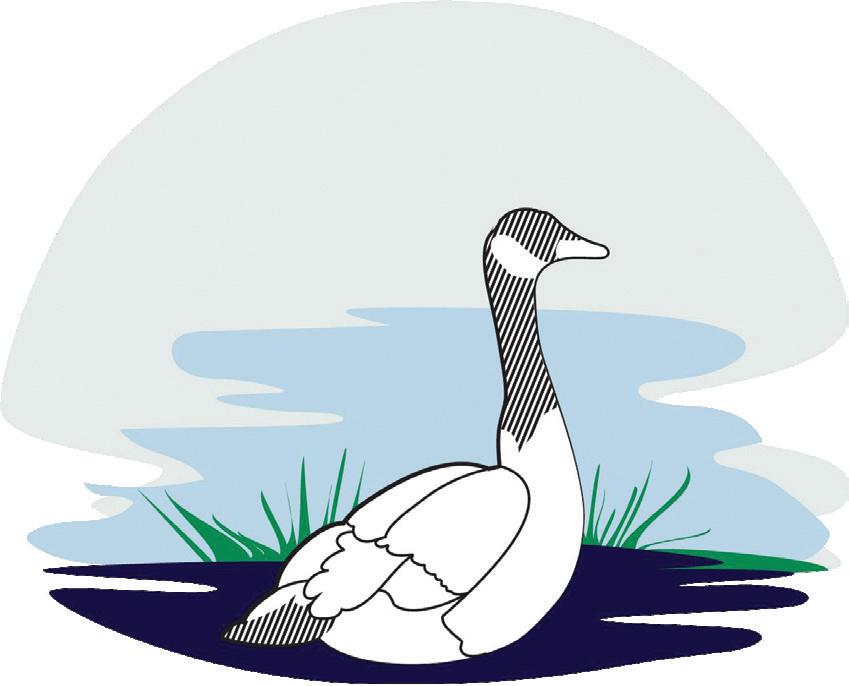


After a typical big thunderstorm in the summer, social media feeds swell with images of borough res idents gleefully paddling down the tor rent of water that rushes past Ramsgate Court on South Franklin Street. Canoes, rafts, and anything else that floats bob in the current as the stream flows by.

Except that it’s not a stream. It’s the road.
On dry days, Goose Creek is a mod est stream incapable of supporting rec reational watercraft filled with revelers. From its origins behind the old Kmart on Paoli Pike, it winds quietly through the borough, disappearing at points underground before reemerging several blocks later, collecting water from its small tributaries along the way and fer rying it all downstream to where it even tually empties into the Chester Creek south of Westtown-Thornbury Elemen tary School.
Over the years, flooding, such as that which occurs on South Franklin Street, has grown both more significant and more frequent. Megan Fork knows the floods all too well, even though she has only been in the neighborhood for a short time. “I’ve lived in my house for five months, and already there have been two rainstorms, just normal thun derstorms,” she says. “But the water’s been up over the banks and over the street.”
She possesses a deeper understand ing of the flooding as well: Dr. Fork is an environmental scientist who studies urban streams and stormwater issues. For the past two years, she has been teaching freshwater ecology and urban ecology at West Chester University, where she is also working on assembling a formal degree program. Before that, she studied urban streams in Durham, North Carolina, as well as in Austin, Texas and Baltimore. With Goose Creek, she sees a familiar pattern. “Becoming such a torrent from an inch and a half of rain speaks to the problem of stormwa ter getting to the stream too fast.”
Fork is also a board member of the Goose Creek Alliance, an organization formed in 2020 dedicated to returning the Goose Creek to good health and function. Their efforts are none too soon.
On a hot day in mid-August, I met Michael Dunn in the parking lot at Greenfield Park, which is across the street from Ramsgate Court and one of the areas most dramatically impacted by the flooding. He took me down along the creek, pointing out where members of the West Chester Green Team planted a host of native plants and shrubs the previous year to help restore the bank. Right along the creek, however, that’s not what I noticed. It stinks here—a vaguely unpleasant odor of decay, rather than the expected freshness of a stream flowing through the woods.
A West Chester native, Dunn is one of the founders of the Goose Creek Alliance and a board member. A men tor once told him that a solid business approach in the environmental sec tor is to find problems that persist and bring solutions and grant funding to the table. Allying with local nonprofits and community groups to build awareness of these issues, and always keeping in context that "the people of the place"



should be primary stakeholders is vitally important. Dunn has parlayed a career in urban forestry, including a stint in the elite wildland fire fighting organization, Arizona’s Mormon Lake Hotshots, into his current role as owner and consulting arborist for Brandywine Urban Forest Consulting.
Pollution is a primary problem with Goose Creek. “When you walk down the street, you see the plastic bag, the oil stain,” says Megan Fork. Lawn fertilizers, dog poop, old tires, and everything else leach out nutrients that don’t belong in the water and find their way into the stream, which in term is absorbed by the algae in the stream. “That’s when you get the stinky, nasty algal blooms,” she explains. “When the algae all die, the decomposition sucks up all the oxy gen in the water, which then kills the fish and whatever else lives there.”
The pollutants don’t just come from lawns and dogs, however; when indus try began to boom in the area, factories dumped their wastewater and other output into the creek. As the sediment rolled along, the banks absorbed some of it, degrading the quality of the soil and the environment of the bank itself.
Instead of the normal plant life along the bank, there is just a grassy ditch on a sunken, eroding bank, like the one next to South Franklin Street across from Greenfield Park.
All those unwanted nutrients then make their way into the Chester Creek, which in turns funnels into the Delaware estuary, contaminating the fish that live there, making pollution a problem, with ripple effects. “The water quality is important not just to those fish, but to the people who fish in the estuary and the ocean,” Forks says. In a very real way,
The above map shows West Chester and its flood plains.
The highlighted area is the segment of goose creek that streams through the borough.

that plastic bag of dog poop floating down the street and into Goose Creek has a direct connection to not having crabs to eat from the Delaware Bay.
And then there is the flooding. Goose Creek itself is about five miles long, but measures about 12 miles in total when the tributaries that feed it along the way are added to the measurement. It is a utilitarian servant, collecting storm water and directing the swollen runoff caused by increasingly savage and fre quent storms.

The flooding affects us all, regardless of where we live. “We’re all paying for public infrastructure, so when it gets damaged, we all pay for that,” Fork says.
And although the flooding affects everyone, not everyone is affected equally. It is not a coincidence that the areas most heavily impacted by Goose Creek floods—Greenfield Park on South Franklin Street and the Melton Center district—are populated by those who historically have had less of a voice in addressing the problems because of their income level, race, or status in the community. Fork has experienced it firsthand in the other places she has worked, too. “The system is set up to push marginalized people into marginalized places,” she says. “People with less socioeconomic power also have less voice in government, so they don’t even try. It’s true in Balti more, it’s true in Austin, and it’s true in Durham.”
When she worked on an urban stream restoration project in Austin, residents in those marginalized areas told her they feel hopeless that the flooding will ever be addressed. “They don’t even try to advocate for change anymore, because they know that the help ‘will go to the rich neighborhoods and not ours,’” Fork recounts. “There is a lack of trust that their needs are not at the forefront of decision making.”
Dunn drove us onto a freshly cleared dirt lot that runs paral lel to the creek along Paoli Pike, where he pointed to where the tree line had been pushed back in order to make more room for the lot. The crumbling remains of two old houses slated for destruction sit nearby, one with an old wheelchair perched precariously on what’s left of the front porch. The image pres ents a stark counterpoint to the vast swath of fresh pavement that an Aldi’s and a Popeye’s Chicken will soon occupy, with the Goose Creek still quietly continuing its journey tucked into the woods just beyond the tree line. It is a poignant metaphor for the tension between responsible development and envi ronmental stewardship.
“All problems stem from stormwater going untreated into the stream too quickly,” explains Megan Fork. It is a matter of both timing and of quantity. “In a forest, the same amount of rain would fall, and the ground would slowly release it, like a sponge,” she continues. “Here, it hits pavement or roots, it hits the drainage system, and it all gets to the stream at once, where the stream can’t deal with that much water all at one time.”
Untreated stormwater has a quality problem as well. “All the lawns with dog poop and fertilizer in them, the bits of tire, leaking oil, trash in the street, even leaves,” she says. “All that gets into the water where it’s not supposed to be.”

Impervious surfaces, such as parking lots, roads, and build ings are the cause. And we keep creating more and more impervious surfaces. “Soil and plants take up those nutrients. The historical way we dealt with stormwater was to route the water quickly past plants and soil into the stream. All the nature-based solutions that could be filtering that stormwater, were instead intentionally bypassed.”

"All problems stem from stormwater going untreated into the stream too quickly." Dr. Megan Fork
"This multifaceted plan will look into pollution reduction credits that can be shared by the various communities along Goose Creek..." –Michael Dunn, BCMA, RCA


Even as green infrastructure design has increased in recent years, moving the water into places with plants and soil rather than pavement, proportion still matters. “If 50% of our land is impervi ous, we could put green infrastructure into the other 50% and it wouldn’t solve the problem,” Fork says.
The Goose Creek Alliance’s next step is to secure a Watershed Action Plan, a process that will allow the borough of West Chester to partner with other communities impacted by the Goose Creek, and secure funding and resources to create an action plan.

Currently, Goose Creek Alliance is fundraising to finance the plan, which will be an integrative study of the resource and provide a blueprint for ecological restoration of the water shed. “This multifaceted plan will look into pollution reduction credits that can be shared by the various communities along Goose Creek, which include West Chester, West Goshen, and Westtown,” Dunn explains. With an estimated cost of $30K-50K, he is hoping to share the cost with the municipal authorities as well as take advantage of grant oppor tunities.
Megan Fork concurs. “We have a great plan that involves residents in the area, and also involves students at WCU by connecting them to a real-world sit uation,” she exudes. “But we are also using their expertise, as residents in the marginalized Melton district and in the student rental district. They have the local knowledge of when and where there are problems. It’s a real opportu nity for them to use their situation to create change.”
Fork has already begun some of the work. This past summer, she worked with two groups of students, one that assessed the effectiveness of the bor ough rain gardens and looked for ways to improve them, and another group that performed an assessment on the Goose Creek corridor. She also describes a graduate student who com pleted an especially impressive project, walking the entire length of the stream and documenting where tributaries and
pipes drain into it, and where erosion was apparent. As a result, there are now sensors located in those eroded areas collecting data every five minutes. The technology is impressive—a SIM card in the sensors provides data in real time. “During a storm, I can watch the water level rise on my phone,” Fork says. She notes how the sensors, designed by
nearby Stroud Water Research Center, have revolutionized stormwater man agement. “Ten years ago in my PhD program, these things cost about $10K, and now they have come down to $1K. Stroud uses open-source design and trains people to build them themselves.”
Part of the solution rests on all our shoulders. “Managing your property by keeping stormwater from impervious surfaces,” Fork explains. “Disconnect ing downspouts and having it go over vegetation instead of into the street or sidewalk. The benefit of that to borough residents is that they get a discount on their stream protection fee, so they get money in their pocket and they’re pro tecting the stream at the same time.”
The flooding affects us all, regardless of where we live.
"We're all paying for public infra structure, so when it gets damaged, we all pay for that."


It can be as simple as planting new trees in the yard, or even just not cutting down a big old tree. Another way to make a dif ference is by participating in stream clean ups and other community projects, such as the one completed by the Green Team in Greenfield Park. Lastly, she stresses the importance of encouraging elected offi cials to be innovative in how we deal with stormwater in our communities.
Goose Creek is never going to sup port a robust trout fishery, she says. But its value includes more than soaking up stormwater. “It can be a nice place to take a walk along the stream, where it looks nice, and smells good. A place with trees that is shady. A green space that connects parts of the stream and provides habitat. But after rain, it will be wet. You might not be able to use a bike path along that stream, or the picnic tables will be muddy for a few days after a storm. Ninety-five percent of the time, it’s a beautiful place to
be, and the other 5% it is doing work that is not compatible with us being there.”
Helping Goose Creek helps the bor ough stay cooler in the summer, too. “Sim ilar to the way that trees cool us by provid ing shade and evapotranspiration of water, a stream that is not receiving super-hot stormwater, but instead filtered through groundwater helps to cool the environ ment,” she says. “The movement of water through the trees and other vegetation, and from the soil into the atmosphere, helps keep that water from contributing to stormwater problems.”
Connecting Goose Creek in a more direct way to the people, and more to its floodplain, in turn creates more of a green space. “Even if you don’t live in the flood zone, you’re contributing to the water shed,” says Megan Fork. “Everything you do impacts what happens downstream from you. Having healthier streams makes for a better place to live.”
A more beautiful and well-managed goose creek benefits us all.

VISIT THEIR WEBSITE: goose-creek-bufc.hub.arcgis.com
SUPPORT THE GOOSE CREEK ALLIANCE: Spread the word and donate to the “Save the Goose” campaign by visiting: donorbox.org/save-the-goose
“Monitor my Watershed” is the publicly available network of water sensors, designed by scientists at the Stroud Water Research Center: monitormywatershed.org
MONITOR THE SENSORS: There are two of these sensors on Goose Creek.
Montgomery Ave: monitormywatershed.org/sites/BCGC2S
Greenfield Park: monitormywatershed.org/sites/BCGC1S

Andrea Mason of Andrea Mason Design is a professional interior designer who wants to help you upgrade your space


Fall always creeps in and gets peo ple yearning for the festive holiday season, as well as a welcome break from the warm weather. The first leaf falls and everyone goes running for the pumpkins. But you can dec orate with more than just pumpkins this year. My favorite embellish ments are the ones that last through Halloween and Thanksgiv ing. Style just once and leave a lasting impression. Here are a few of my favorites!
Brown tones are a big hit in 2022. Embrace this warm and rich color and its variations and bring them into your decor this fall. Try cozy caramel wool blankets to snuggle under and tablescapes with palettes from rusts to auburns to enhance your autumn meals. Add a bit of glamor with a sequined coffee-brown pillow, or some vivid earth tones via faux or real flowers and other flora in a vase. Implementing these colors throughout the house will immediately transport you to a crisp fall day.
Pattern plays an important part in home decor, and it’s a per fect way to introduce some personality. Plaid is a timeless look that can certainly be used year-round, but it really has its moment in the colder months. Plaids can be displayed in endless ways: in your pillows, throw blankets, table linens, vases—the list goes on. Plaids go a long way in helping to bring fall feels to your space.
Foliage is a tranquil way to bring the outdoor beauty of fall indoors. I love seeing a beautiful vase overflowing with eucalyptus or aspens. Outdoor elements play a huge role inside our homes— they make us feel good and create a peaceful atmosphere just by being there. Adorn your dining table or your console with these beauties for a true fall experience. It doesn’t have to stop at a vase of flowers; you can also use this colorful season as an opportunity to hang artwork with hints of fall foliage or find leaf patterns for your linens and other household accessories.
Seek out metal materials with your vases, frames, and center pieces like candlesticks, and of course even on our perennial favor ites: pumpkins and gourds. Autumn is the best season to use the warm tones of pewters, coppers, and beautiful brasses. I also love seeing these tones in silverware and glassware—such a perfect way to offer a toast to the fall holiday season. Enhance any space with these glitzy metal materials that will add a moody and spicy ambiance to the season!
Candles and fireplaces are an important part of ambiance, and —especially during the chilly onset of the season—fire plays a major role. Light your candles, scented or unscented, and strike up a blaze in the hearth or your firepit. It’s sure to make you feel like fall is upon us as you curl up with your favorite beverage, book and blanket.
There are so many opportunities to mindfully select decor to carry you through the autumn months. It’s a fun way to celebrate the cozy and cool weather coming in. Have a lovely fall everyone and enjoy the holidays to come!
amason@thewcpress.com
Get every issue of this magazine in your mailbox, for free. We promise, there’s no catch.
Just scan this QR code or visit thewcpress.com/subscribe




With miles of rolling hills and a rich history of country living, West Chester is abundant with horse stables. Even a short drive through the bor ough’s surrounding farmland yields idyllic views of horses grazing in their pastures, swishing their tails in quiet fulfillment.
Chester County is, after all, known as Pennsylvania horse country. A recent survey by Delaware Valley University reported that there are around 10,000 horses in Chester and Delaware counties. With thousands of horses and passion ate equestrians committed to their care, a unique horse culture exists here—one that is both steeped in tradition and con tinues to welcome new enthusiasts to their ranks.
With equestrian sports, lesson pro grams, events, and competitions, there are so many ways to experience the magic of horses in and around West Chester, whether you’re a longtime horse lover or just curious about them.
While it’s easy to romanticize the life style, horses require a lot of time and com mitment. Owning, caring for, and regularly
riding these powerful animals involves a constant and unwavering level of love and dedication.
We wanted to see what it’s really like, so we visited three WC barns: Out of Reach Farm, Quest Therapeutics Services, and Indian Deep Farm—to experience firsthand a day in the life (or more fittingly, saddle) of West Chester’s equestrian community.
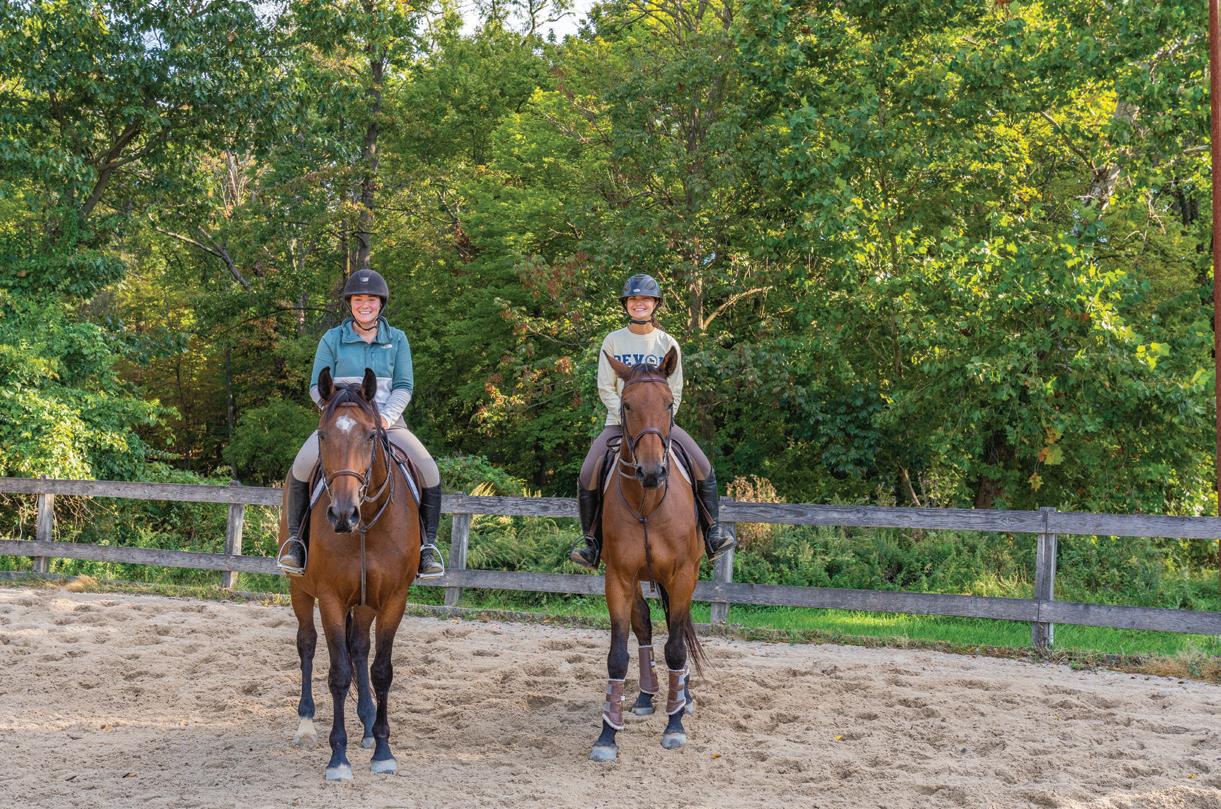
A short drive down Paoli Pike will take you to Out of Reach Farm, a full-service hunter/jumper barn on 45 acres just beyond the sprawl of West Chester’s busi ness parks and residential neighborhoods. Its lush pastures and an eye-catching silo stand tall over an expansive facility that’s home to over 40 horses.
The farm is owned by Dawn Taylor-Bell, a lifelong equestrian who fell in love with riding horses at age seven. From her first riding experience, Dawn knew that a career with horses was in her future. In 1997, she opened Out of Reach Farm, and ever since, the barn has been successfully operating.
Out of Reach Farm cultivates a close-knit community of equestrians of all ages and experience levels.
Today, it’s a cherished riding institution that has cultivated a close-knit commu nity of equestrians of all ages and experi ence levels. “It’s a family type barn,” says Taylor-Bell. “Many of my clients have been with me for 20 years.” There’s a mix of riders, from those training to compete to beginners learning the foundations of riding. Additionally, private owners who board horses at OORF saddle up and enjoy the indoor and outdoor rings equipped with full jump courses.
As owner and trainer, Taylor-Bell’s daily schedule is never the same. Between run ning the business operations, training rid ers, and traveling with her team to week end horse shows, her days are packed from morning to evening—and she does it with a steadfast mission to help others succeed in their riding goals while instill ing in them a love and respect for horses.
Mornings at the farm start at 7:30am, when the horses are turned in (brought



in from pasture), taken to their stalls for breakfast and then prepped for their day’s activities. A full-service boarding facility, OORF provides boarding and care for cli ents’ horses including stall cleaning, turn ing in/out, grooming/washing, medical and farrier care. Even if a horse isn’t being ridden that day, they might be scheduled to get new horseshoes or have a veteri nary appointment.
Taylor-Bell splits her time between her home office and the bar, where she teaches three to four times a week. She may teach as early as 7:30 am or afternoons until 4:00pm. After lessons, Taylor-Bell returns to her office for paperwork and to research horse shows to enter. While she’s at the office, her assistant, Lauren Ranji, runs the operations and teaches lessons for OORF’s riding program. By 3:30pm it’s feeding time for many of the horses and time to turn out. Ranji continues teaching from 3:30 to 7:30pm. That’s a 12-hour day at Out of Reach.
Horses are a 24-hour/seven-days-aweek commitment. And if they’re not at the barn, Taylor-Bell and her team like to
It’s more than just the horses — Out of Reach Farm exemplifies the beauty of Chester County.

compete in hunter/jumper shows on the weekends. Hunter/jumper is a discipline commonly known as show jumping. At these competitions, riders and horses compete in hunter classes, judging the horse’s performance over fences; jumper classes, judging the horse’s athletic ability measured by time; and equitation classes, judging the rider’s overall athletic ability, form, and horsemanship skills.
“I attend horse shows almost every weekend—45 to 48 shows each year,” Taylor-Bell says. When we spoke, Tay lor-Bell was looking forward to a local derby show the upcoming weekend and the Fair Hill Thoroughbred Horse Show, in which she planned to show six or seven of OORF’s own Thoroughbreds.
Between boarding, lessons, and shows, Taylor-Bell interacts with horses daily. She has created a career spanning more than 20 years, one whose success is reflected in her student’s accomplishments, staff’s
loyalty, and the health of the horses in her care. Her advice for someone who may be interested in riding: “Support the children who really want [to ride]. Riding horses is not an inexpensive sport; it’s a hard sport, a great sport. Horses can give your kids something that no other sport can, but you must be willing to back up their love of it.”
Just west of the borough, you’ll find a handsome wood-paneled facility on 10 acres of land that’s home to Quest Ther apeutic Services, a full-time 501(c)(3) not-for-profit pediatric therapy center dedicated to enhancing the lives of chil dren with disabilities. But this therapy center also has a unique component: Equine-Assisted Therapy, also known as hippotherapy, which is a treatment involv ing interactions with horses, specifically their movements.
Quest was established in 1996 by Sandy McCloskey, a physical therapist and passionate equestrian, who sought to blend her love of horses with her pediat


ric physical therapy career. Today, Quest serves over 125 children per week through a variety of services including Early Inter vention, Physical and Occupational Ther apy, and Hippotherapy. Sadly, Sandy passed away in 2016, but her legacy and love of horses lives on in the dedicated therapy work and equine experiences the staff provides for their clients.
At the helm is Executive Director Lisa Newcomb, who although not an eques trian herself, is closely involved in daily operations at Quest, including the barn that’s home to eight ponies and one mini pony. “Every day is different. I usually split my time between helping our front office manager and focusing on fund raising,” says Newcomb. “[But] we are a small enough facility that I can collaborate on different things as needed. I trust the co-barn managers, Jess Benner and Linda Hershey, [to manage the barn] and do what I can to support them.” The facility has eight therapists, along with barn man agers, an office manager, and several vol unteers.
While hippotherapy is their distinc tion, Quest is not solely an equine facility.
Instead, hippotherapy is a component of the comprehensive occupational and physical therapy services they provide— one that comes with some cute coun terparts. The herd at Quest includes Nessa, Finn, Mr. Chuckles, Elsa, Tobin, Grey Wolf, Chex, and Mini Cooper, an aptly named miniature horse. It’s soon revealed that he’s got quite the personal ity, too. “He can be pretty ornery,’’ chuck les Newcomb.
A typical day at Quest begins early, when the barn staff arrive and, since the ponies sleep out overnight, are brought in to be fed and groomed. Monday through Thursday, children start arriving at 1:30pm, so mornings for the ponies are usually reserved for medical care or warm-up exercises. These exercises may include barn staff lunging (guiding the ponies in large circles) or riding them.
Children’s therapy sessions typically last 45 minutes, with 15 to 20 minutes of that time spent on their assigned pony. During the equine sessions, a licensed therapist works directly with the client while a volunteer leads the pony, and a side walker accompanies to ensure the
Quest is not solely a hippotherapy facility — they offer comprehensive occupational and physical therapy.
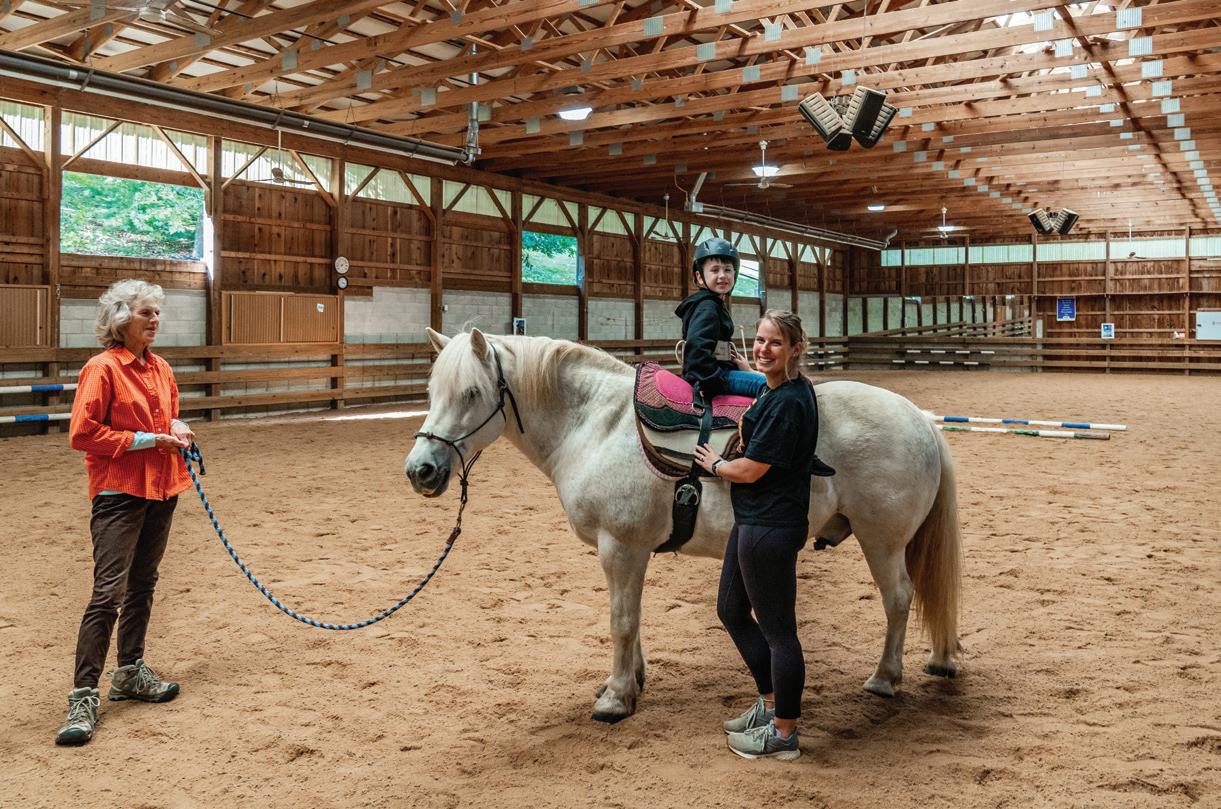
child’s safety. During their treatment, a client typically rides bareback or on a sad dle pad and may sit forwards, backwards, sideways, on their hands and knees, or read books and sing songs. During these exercises, the volunteer leading the pony remains in control. Newcomb explains that at Quest the goal is not to teach their clients to ride, but instead use the move ments and rhythmic patterns of the pony to help assist in their therapy treatment.
When a new pony joins the program, they undergo a months-long evaluation process before they are eligible to partic ipate in therapy service. The barn man agers desensitize and train the ponies to prepare them for sessions. In addition to sessions on the ponies, clients can also participate in barn work like grooming, fill ing hay nets and water buckets, painting the ponies, and yes, even scooping poop. These activities have proven to be effec tive for sensory regulation and muscle building. With so much interaction with


the ponies, ensuring that they are com fortable helps to create a safe and fun environment for the children.
Quest therapists see two to five cli ents each day. Sessions usually wrap up by 7pm, and then it’s time to turn out the ponies. They’re taken to their paddocks where they will spend the night.
The care and dedication that Quest puts into creating a safe, effective envi ronment for their clients is clear from the moment you walk in. The warm, vibrant atmosphere created by the team is further enhanced by the calm, nurturing nature of their ponies. At times, Quest has a yearlong waitlist for new clients, although Newcomb emphasizes that they are always willing to figure out the right fit for prospective clients. For those interested in working with the ponies in a therapeutic capacity, Quest is always open to meeting new people and actively accepts applica tions for volunteers.
Newcomb and her team are constantly thinking of ways to improve the barn and uphold Quest’s mission to provide a full range of pediatric services to children with disabilities. “Our dream in the next two months is to pave [the grassy area here] so the kids can ride their bikes and loop through the barn.” Bike rides along side ponies? We can just see Mini Cooper cheering them on from his stall as they zoom by.
A few minutes down the road from Quest Therapeutics sits Indian Deep Farm, a privately owned farm built in the 1800s, including a cottage and land for horses. For the past six years, equestrian Adrienne Morella has taken care of her two Arabians, King and Sammy, here.

If Morella looks familiar, you may have seen her gracing your television screen. In addition to being an accomplished eques trian, Morella is a regular full-time model at QVC, modeling plus-size fashions for brands like H by Halston, Isaac Mizrahi, and Susan Graver. Morella is also a tal
ent behind the lens, running a success ful photography business specializing in equestrian, portrait, and fashion photog raphy. “I’ve been able to make a living off these three passions: horses, fashion, and photography,” says Morella, who recently landed the coveted role of shooting the cover of Sidelines magazine, a sport publi cation for equestrians.
How did she cultivate this ‘horses and high fashion’ lifestyle? “I’ve been a horse person since I was born,” explains Morella. “My mother got me into it. I was born and raised in Delaware County, and we boarded horses at a farm in Glen Mills.”
If our cover model looks familiar, that’s because you may have seen Adrienne Morella, pictured here with her Arabians King and Sammy, on TV; she’s a full-time model on QVC.
Over time, her love for horses steadily grew, and she is proud that her roots helped her branch out into other aspects of equestrianism.
At Indian Deep Farm, Morella’s day begins at 8:00am when she brings her horses in for breakfast and fresh hay and preps their stall for the day. She cleans, feeds, and exercises the horses daily,



typically riding four to five times a week. Depending on the day, Morella may pro vide her horses with medical care like femur treatments, massage, or therapeu tic blankets. By 4:00 or 5:00pm each day, it’s time to feed them dinner and put them back out in the field.
As a private owner and competitor, Morella offers a unique perspective into the equestrian lifestyle. “[Horse owner ship] is definitely something that if you’re really into it, to truly live it, you have to do everything,” explains Morella. “Clean their stalls, take care of them—it’s the experi ence you get from really living it.”
Morella is the proud owner of a pure bred Arabian gelding, King’s Ransom EE++/, or King for short. Those sym bols following his name are intentional. Morella explains that the symbols are per manent additions since he has won 300 points in rated competition. With every 75 points, a horse gets a symbol perma nently attached to its registered name. Morella has owned King for nine years and competed with him all over the coun try, including dressage, hunter, and ranch riding. Just last year, Morella earned a Top
Morella is an accomplished dressage rider and will once again have the honor of carrying the American flag during the National Anthem to open the Dressage at Devon.

10 placement in the country and traveled to compete in the Arabian U.S. Nationals in Oklahoma, placing 7th in her class. She also had the honor of carrying the Amer ican flag while riding King as the National Anthem played to open the competition.
Morella’s second horse is a Shagya Ara bian, KB Royal Samurai AF, or Sammy. The letters in his registered name reflect his breeder and former owner. Shagya Arabi ans are rare, developed for use in war in the Austro-Hungarian Empire during the 19th century. Arabian stallions were bred with Hungarian mares to create Shagya Arabians. Today, they are celebrated for their speed and muscular build. Morella has taken Sammy to all her shows— including the U.S. Nationals to accom pany King—and currently competes in dressage competition with him. When we spoke, she was looking forward to the upcoming Dressage at Devon, where
she would once again have the opportu nity to carry the American flag during the National Anthem.
From photo shoots to the show ring, Morella brings a sense of creative expres sion into her equestrian life. But behind the glamor, she’s a true horsewoman who isn’t afraid of the hard work. She is forth right in her advice to those interested in riding. “My recommendation is to take riding lessons, learn about horses, and do a lease if it’s something you really want to do,” she says. “It can offer amazing, won derful, opportunities, but if you’re not liv ing/breathing/sleeping horses, it can be difficult. It’s costly, time consuming, and there’s a tradeoff. Horse ownership is defi nitely a lifestyle.”
After spending time with these eques trians, it’s clear to see the dedication and passion that goes into cultivating a life with horses, and a glimpse into their daily schedules reveal the hard work and com mitment involved. Whether running a successful business, providing a service, or turning a passion into a profession, a life with horses requires a lot of heart. And it’s worth it.

Resident astrologer Kate Chadwick provides your planetary predictions with a particularly local twist
Aries (3/21-4/19): The stars are suggesting you get your act together this season: eating better, work-life balance, plenty of sleep—you know, grownup stuff. Start with new glasses at Artistic Eyewear. You’ll want to clearly see how much ass you’re gonna kick.

Taurus (4/20-5/20): Lean into a hobby you love this fall, bulls. You are the homebody-est of homebodies—maybe tap into your inner artiste and make something special at Painted Plate for your home. Solo project or make it a party? You decide.
Gemini (5/21-6/20) You’re a gypsy at heart, twin star, but autumn will be all about home and family and you’re hosting. Get your house in guest-ready condition with a heating tune-up from Sheller Oil and fall décor from Giunta’s Furniture.

Cancer (6/21-7/22) Out and about is where you’ll be this fall, crab friends, not just socially, but possibly for work…? Speaking and writing seem to be on the table, so make sure you dress to impress because all eyes will be on you. Hit refresh at Kaly.
Leo (7/23-8/22) Burning through money is your superpower, kit ty-cats, in your quest to see and be seen. But your wallet can’t keep up with your ego this fall. Swap out restaurants for groceries at Colonial Meat Market and shine in your own kitchen.

Virgo (8/23-9/22) You’re all about service, Virgo, but the stars want you to put yourself first now. As independent as you are, that’s not a problem. That confidence will be magnetic, so you may attract someone just picking up Wings to Go.
Libra (9/23-10/22) Lovelies: you’ve been running yourself into the ground. It’s time to rest. Not just getting your zzzz’s but getting centered and feeding your spirit. Whether that’s yoga, meditation, or volunteering, get out of your own head.
Scorpio (10/23-11/22) You’ll find yourself in many group activities this fall, Scorpions. Not your favorite, but keep your modern, mys terious, minimalist cool and you’ll fly under the radar. Basic black and dark glasses from Phineas Gage and you’re golden.
Sagittarius (11/23-12/21) You love to play, archer babes, but this fall, work is the focus. Is it overtime? Is it a promotion? Or will you chuck everything for a total career change? Keep your ears open for opportunity, even if you’re just sitting at the bar at Avalon.
Capricorn (12/22-1/19) Your horizons will widen this fall, goat friends, whether that means international travel or an online course. Or it could be a complete overhaul for your look? Book a spa visit and vive La Difference.
Aquarius (1/20-2/18) Autumn is all about learning this year, water-bearers—you’re like a sponge. Get to the library and check out books and media on psychology and/or self-help. Maybe open up a bit to the people who love you?
Pisces (2/19-3/20) It’s snuggle time for you, fish friends. And you are ready. If you’ve got a significant other (or not), plan a little get away. Budget issues? Visit a local park, throw down a blanket, and just look at those leaves.


 story DANIELLE DAVIES
story DANIELLE DAVIES


Ask any parent and they’ll be able to commiserate—it’s not always easy getting your kids to do something. For some parents, those difficult moments may come infrequently: getting toddlers to wear a fancy dress or pair of shoes at a holiday party or a school-age child to buckle up for a doctor’s appointment. For others, it’s a daily struggle that comes with fre quent reminders to brush their teeth, drive the speed limit, or study for a test, depending on the age of the child. Par enting is a tough gig.
And yet, some children have a par ticular sense of drive and ambition even at a very young age—sometimes shock ingly young. And while you can often find these children at the top of their class, or as musical prodigies, or proving their prowess on an athletic field, you can find quite a number of them locally at Ice Line.
Ice Line is a quad rink ice facility right here in West Chester. The build ing consists of four National Hockey
League-regulation ice surfaces and is home to several pretty impressive pro grams including West Chester Univer sity, Jr. Flyers, and Team Philadelphia Hockey Clubs. It’s also home to the Ice Line Figure Skating Club.
And though Ice Line is a local facility, the skills and talent of the skaters in the Figure Skating Club, ages four and up, goes far beyond local geography. In fact, this year, 13 skaters made it past quali fying competitions in either Pennsylva nia (the Keystone State Games) or New York (The Empire State Games) and attended the State Games of America.
“We actually had 45 skaters qualify to go to the State Games of America, but it’s hard to coordinate. We were traveling to Iowa in the summertime,” explains Ice Line Synchronized Skating and private coach Kate Blanchette.
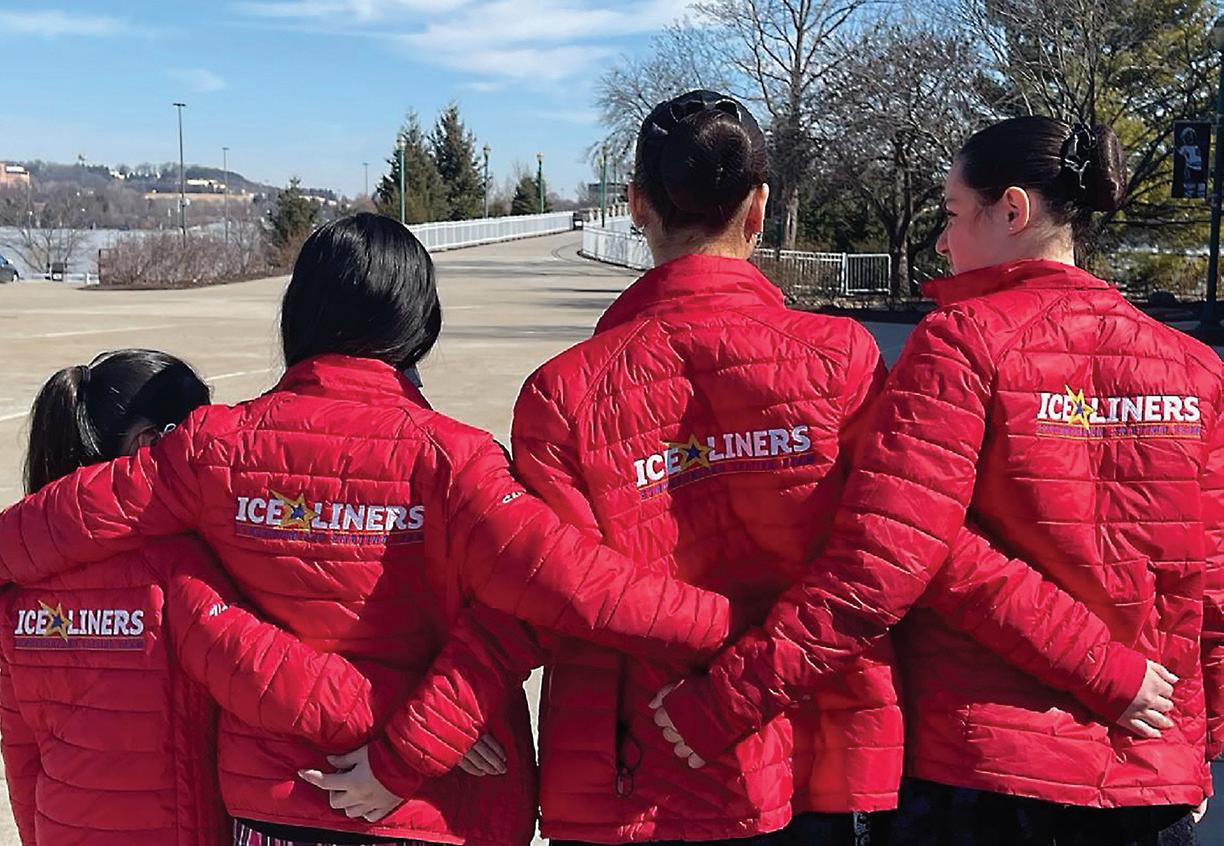
According to StateGamesofAmerica. com, “The State Games of America is a biennial Olympic-style event featur ing competition between State Games medal winners (gold, silver, bronze)
“I brought the Ice Liners, which is a synchronized skating team, to Ice Line Figure Skating Club and from there, it kind of just started really developing and growing into this fantastic club that we have now.”
–Kate Blanchettefrom across the nation. There are cur rently 30 states conducting or organiz ing statewide sports festivals known as State Games.”
Much like the Olympics, the State Games of America are held at a different location every two years with opening ceremonies, a parade of athletes, and competition from participants across several different disciplines. This year’s competition was comprised of over 50 sports including soccer, swimming, gymnastics, track and field, powerlifting,



and of course, figure skating. According to the San Diego Bowl Game Associa tion, “more than 18,000 athletes are expected to compete” at the 2024 State Games of America in San Diego.
Among the winners were Emma Blanchette, age 16, with three gold med als; Andrew Carver, age 16, with one gold medal; Shirina Gao, age 11, with one silver medal; Ava Faktor, age 11, with one gold and two bronze medals; James Zhu, age 11, with one gold medal; Avery Rhatican, age 11, with two gold, one sil ver, and one bronze medal; Brielle Sol omon, age 11, with two gold, one silver, and one bronze medal; Sofia Tang, age

11, with two gold and one silver medal; Morgan Beisser, age 10, with three gold medals; Shana Shen, age 10, with one gold, one silver, and one bronze medal; Emma Rodriguez, age 10, with three gold and one silver medal; Vanessa Feng, age 9, with one silver and one bronze medal; and Katherine Li, age 8, with three gold medals.
Just getting to the State Games of America is a huge challenge. Prior to qualifying events in their own states,
skaters must advance via tests within each discipline, training with private coaches and instructors, and putting in countless practice hours. To actu ally earn a medal at the State Games of America takes a special kind of dis cipline, commitment, and a profound love of skating. And yet, that’s what all 13 skaters from Ice Line Figure Skaters managed to do, automatically qualify ing them for the 2024 State Games of America.
High stakes competitions aren’t for everyone. But these kids—as well as their families and coaches—have shown they’ve got what it takes to do the nearly

impossible. And though they may make it look easy, it’s anything but.
“It takes commitment,” says Coach Jenny Laraio. “Commitment on the skat er’s part, and that can be challenging because these kids, they’re just learning what it means to be committed. Com mitment for them to come and not only show up but to actually set some goals and work towards those goals, even if it means failing. It takes commitment from their families to bring them. It’s a finan cial commitment, a time commitment, a travel commitment. And a commitment from the coaches themselves.”
“It definitely takes a lot of dedica tion and hard work. There’s lots of fall ing down and getting up again,” says Blanchette. “These kids have so much confidence in themselves. They are quite spirited, being young and deter mined. It’s unbelievable when you see it, and they all have such a great team camaraderie.”
“I’m so excited and blessed to be able to share this sport and the passion and love that I have, and to support these other skaters coming up and growing and being part of their journey.”
–Kate BlanchetteWith so much dedication and responsibility required, especially of kids—many of whom participate in other sports, school activities, and aca demics—it’s critical to recognize that it does indeed take a village.
“These kids probably practice eight to ten hours a week, before school, and during the summer it might be up to 30,” says Stephanie Beisser, mother of ten-year-old Morgan Beisser. “To have a competitive figure skater, it takes a full family commitment, as well as time and money. But the kids themselves, they’re all self-driven. They’re all at the top of their class. They’re competitive, but they’re so supportive of each other.”
While their camaraderie isn’t unheard of in the world of competitive skating,
it’s a particularly tight-knit community at Ice Line, where the program is still fairly new.
“The figure skating club had been around for quite some time, but it really didn’t start picking up until 2017,” says Blanchette. “That’s when I came, and some other coaches came here. I brought the Ice Liners, which is a synchronized skating team, to Ice Line Figure Skating Club and from there, it kind of just started really developing and growing into this fantastic club that we have now.”
“Various coaches have worked really hard to establish a Figure Skating Club, and then to build that club, and estab lish it as a thriving program has taken some time,” says Laraio. “I’ve been there

throughout that process and when we look back, it did come together pretty quickly, and we’ve seen success pretty quickly as well. And I think that’s just due to everybody working together to make it a reality.”
The result of this closely connected community in the skating world, and at Ice Line—in addition to their technical skills and athletic prowess—are the life long friendships made on the rink. “Her best friends are more from the rink than from school because of how much time we spend there,” says Beisser.
For Blanchette, those friendships are part of the draw. “I’m so excited and blessed to be able to share this sport and the passion and love that I have, and


to support these other skaters coming up and growing and being part of their journey,” she says.
That’s part of the reason that Blanch ette, who had most recently coached in Syracuse, wanted to build up a synchro nized skating program when she moved to the area. “I wanted to start my own organization for synchronized skating,” says Blanchette. “But we needed a home for the skaters to grow and to have these kids be able to start at the grass roots, from just the beginning, and grow and get everything at one arena. We were lucky enough that Ice Line took us in. They had their own club, but we built it from there.”
These days, the program consists of over 70 skaters, all of whom show a tre mendous amount of dedication to the program, their coaches, and each other. And though figure skating can be a com petitive sport, as evidenced by the prow ess and awards of the athletes involved, it doesn’t have to be. And that’s kind of
what makes it so much fun.
“Skating is such a wonderful sport because there is something for every age,” says Blanchette. “There are all dif ferent levels. You can be a recreational skater and come once a week or do group lessons to learn to skate with your friends at a Friday night free skate. There are all levels. That’s why I ask all my students, ‘Where do you see your self? What do you want to get out of it?’ Some want to go to the Olympics. Some want to take all their tests and become a gold medalist in the eyes of US Fig ure Skating. Nowadays they have figure skating teams in college. The growth of the industry is wonderful.”
Both Laraio and Blanchette are them selves products of the skating world. For Blanchette, her competitive skating jour ney started when she was three years old and continued through high school, culminating in 1994 at the Invitational World Cup in France. She began coach
ing at a rink in Massachusetts while she was in college and made it her full-time job—transitioning out of the finance pro fession after the birth of her second child.
For Laraio, who started skating when she was six, she fell in love with the ath leticism of the sport and the artistry, and being able to express a story in the music. Though she works full time as a cell biologist, she continues to make time for coaching due to the relationships she’s made with other coaches and skat ers, and the great family environment.
“I had many coaches who were influ ential in my life,” says Laraio. “I did mul tiple sports and had lots of coaches in different environments, but in figure skating especially, it’s really beneficial to the skater to have multiple coaches.



There are multiple disciplines, and it helps skaters develop across the board. I am a free skate coach, but I work very closely with coaches in movements in the field. Those are some of those tech nical skills that the skaters develop for turns and edges that kind of translate into their free skate program. So, I work closely with coaches that focus on that discipline as well as ice dancing.”
As former youth athletes themselves, Laraio and Blanchette, along with the other coaches at Ice Line, understand both the benefit of a tight-knit coaching family and the need for fun.
“The one thing that makes it all a lit tle easier is our commitment to having fun while we do it,” says Laraio. “This can be a really difficult sport. It’s getting out there in front of people all by your self and putting on a show. But we look for things the kids can do together, fun drills, the synchro team. We’ll make the drills silly. If it’s not fun for them, they’re not going to be as committed.”
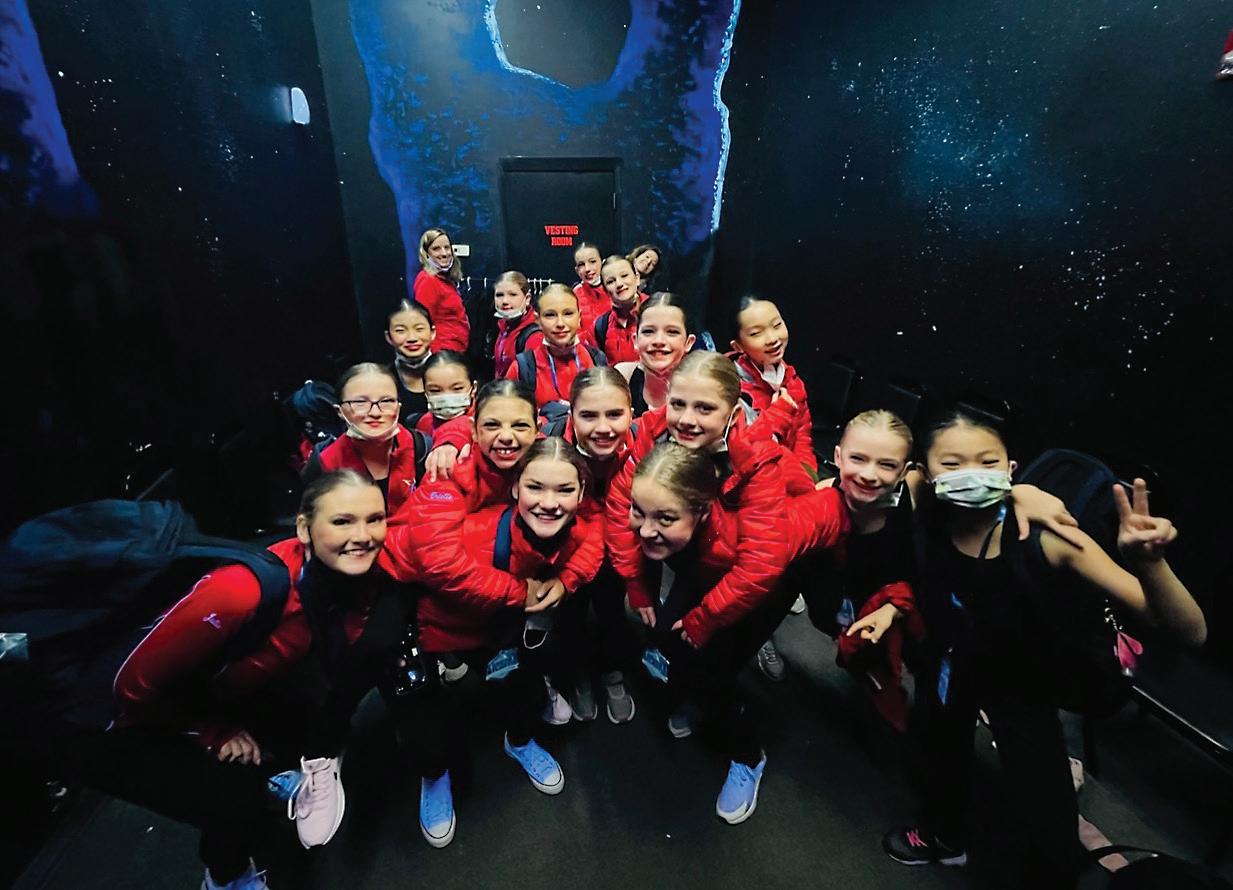
This type of dedication from the coaching staff is one of the reasons Ice Line is so successful and feels so much like a family—there’s competition, but even more than that, support both for and from the athletes. Blanchette, Laraio, and Beisser all mentioned that when one skater is learning a new skill at a group lesson, the others sit, wait, and cheer on their teammate.
“The skaters are really excited for each other all the time. That’s some thing I really love about our club,” says Laraio. “There are other clubs where it’s more of a cutthroat environment within the club itself. [At Ice Line], we have wanted it to be fun and enjoyable for the coaches as well as the students. And I think that’s really working to our advan tage. We work together as coaches and the kids see that, and then they want
to work together and support each other as much as they can. And that’s so much more fun for them. I think the more positive environment helps the kids to thrive.”
The parents also help perpetuate the positive environment for their kids, playing an active role in the culture of the team. Beisser pointed out that the parents aren’t like those you might have seen on television’s Dance Moms; instead, they are all supportive of each other and their children.
“One of the moms put together a mas ter list of when each skater was compet ing for the State Games of America,” says Blanchette, who explains that they don’t all compete at the same time, or even on the same days. “And every skater would come in and make sure the others had a cheering crowd. I have the best job ever. It doesn’t matter what they’re doing. When they achieve something, it’s like a party on the ice.”

HomeBecca Boyd shares tips on life and cooking on her blog at homebeccanomics.com

It’s the season of sweaters and changing leaves, so I’m sharing some dishes to match the weather. We make these peanut butter balls nearly weekly in my house. With an ingredient list full of pronounce able and healthy all-stars, it comes together in minutes and lasts indefi nitely. And don’t give me side-eye on the stew—different can be extraordinary, and this nourishing and outlandishly flavorful dish is proof. –bboyd@thewcpress.com
Peanut Butter Oatmeal Balls makes about 20
3/4 c. natural peanut butter
1/2 c. mini bittersweet choco late chips
2 c. old fashioned (rolled) oats
3 tbsp. ground flax seed
2 tbsp. maple syrup
1/2 tsp. kosher salt
3 tbsp. chia seeds
1/4 c. honey
1 tsp. vanilla
1. Whisk peanut butter, maple syrup, vanilla, and salt together until smooth. Add seeds and stir. Add oats and chips and stir.
2. Using a scoop, portion out into balls and place in a container or on a plate.
3. Refrigerate until firm, about 30 minutes, then store in the fridge in a sealed container.
Chickpea Coconut Stew with Sweet Potatoes & Swiss chard serves 4-6
1 1/2 Tbsp. grated fresh ginger
1 1/2 Tbsp. minced (or pressed through garlic press) garlic
1 (large) sweet potato, cut into small cubes
4 c. canned chickpeas, drained and rinsed
2 bunches Swiss chard, leaves only, chopped
1/4 c. olive oil
2 onions, diced
1 1/4 tsp. kosher salt
3/4 tsp. ground pepper
1 1/2 tsp. ground turmeric
1 tsp. ground coriander
2 cans full fat coconut milk
2 c. chicken or vegetable broth
Juice of 1 lime
1/4 c. finely chopped cilantro, leaves and tender stems only
To serve – plain Greek style yogurt, crushed red pepper flakes, olive oil, more cilantro
1. In a large pot, heat olive oil over medium heat. Add onions, gin ger, garlic, salt, pepper, and sweet potatoes. Let cook, stirring occa sionally, until thoroughly softened and fragrant (about 5 minutes).
2. Add chickpeas, turmeric, and coriander and stir. Let cook for about 8 minutes without stirring. Bottom of the pan can get brown but don’t let it get too dark.
3. Add coconut milk and broth and stir, scraping up the brown bits. Once mixture comes to a boil, reduce heat to simmer. Cook for 30 minutes, stirring occasionally.
4. Add Swiss Chard and stir until wilted.
5. Remove from heat and add lime juice and cilantro. Salt to taste.
6. Serve with desired accoutrements.









DJ Romeo curates a list of the tracks you’ll be singing all season long

The following is a list of songs that will take over the radio stations in the next few months. You’ll soon know them by heart and play them ‘til they’re tired. And, you can now stream the list in its entirey at: www.thewcpress.com/playlist @DJRomeo24 | www.DJRomeo.fm
Unholy – Sam Smith, Kim Petras

I’m Good (Blue) – David Guetta, Bebe Rexha
I Like You (A Happier Song) – Post Malone, Doja Cat Shut Down – BLACKPINK
Hold Me Closer – Elton John, Britney Spears Left and Right – Charlie Puth, Jung Kook, BTS Take Me High – Kx5, deadmau5, Kaskade Betty (Get Money) – Yung Gravy
2 Be Loved (Am I Ready) – Lizzo Bones – Imagine Dragons
MUSCLE MEMORY – Kelsea Ballerini
Bad Omens – 5 Seconds of Summer Woke Up in Love – Kygo, Gryffin, Calum Scott Million Dollar Baby – Ava Max Satelitte – Khalid
SNAP – Rosa Linn

Late Night Talking – Harry Styles Calm Down – Rema, Selena Gomez Numb – Marshmello, Khalid Whiskey On You – Nate Smith
Grand – Kane Brown So Good – Halsey
Super Freaky Girl – Nicki Minaj
STAR WALKIN’ (League of Legends Worlds Anthem) – Lil Nas X Evergreen (You Didn’t Deserve Me At All) – Omar Apollo How Do I Say Goodbye – Dean Lewis Make You Say – Zedd, Maren Morris, BEAUZ Only Fan – Bazzi, Cordae All That Really Matters – ILLENIUM, Teddy Swims
DON’T YOU WORRY – Black Eyed Peas, Shakira, David Guetta
